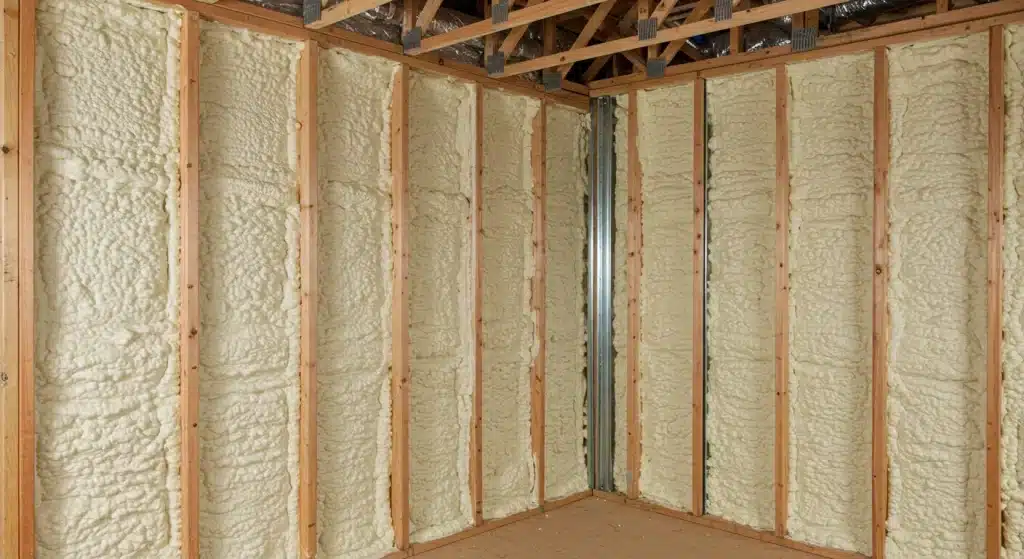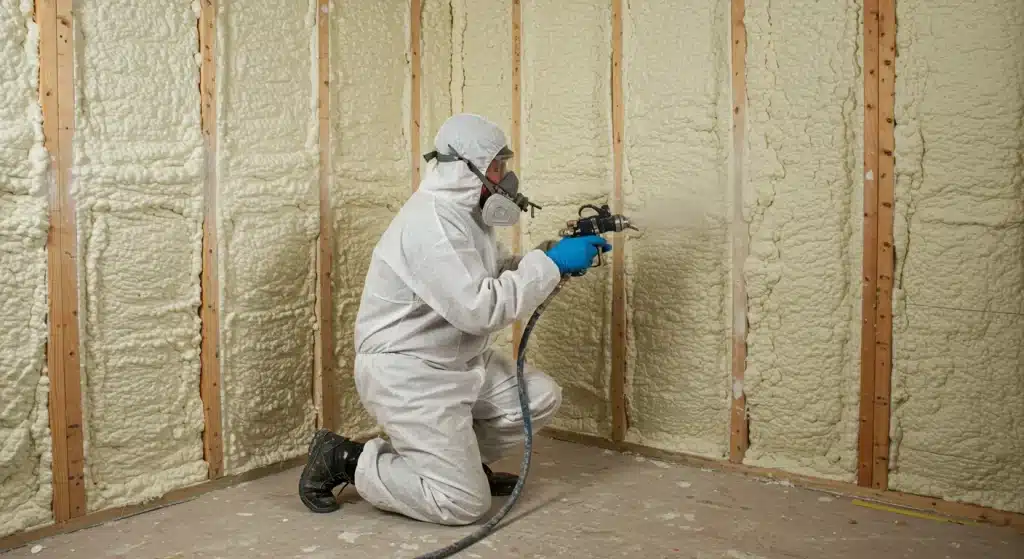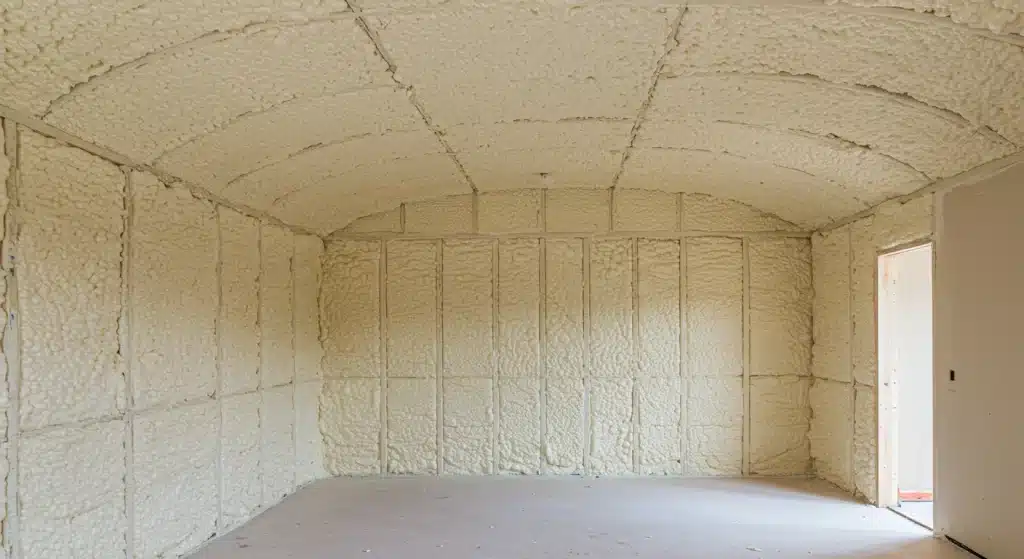The challenge facing Sunrise Manor homeowners isn’t just the summer heat; it’s the intense thermal shock caused by the rapid cycling of high daytime heat and surprising nighttime and winter dips. To shield a home effectively against this constant change in temperature, the immediate solution is a high-performing thermal envelope created through effective insulation and air sealing. This strategy prevents uncontrolled heat transfer, stabilizes indoor temperatures, and drastically cuts down the load on heating and cooling equipment.
Protecting a home requires understanding how heat moves in a desert climate. In the summer, heat energy tries to flow from the outside (hot) to the inside (cooler). In the winter, the reverse happens, with indoor heat escaping easily to the cold exterior. Quality insulation works as a dependable barrier against this heat flow, ensuring the home remains comfortable year-round, regardless of the seasonal extremes outside your door.
Understanding the Sunrise Manor Climate Challenge
Living near Las Vegas means dealing with Climate Zone 3, characterized by hot, dry summers. However, many residents overlook the surprisingly cool winters, where temperatures can drop near freezing, especially overnight. This wide seasonal swing puts continuous stress on the home’s structure and mechanical systems.
When a home lacks adequate insulation, materials like stucco, roofing, and concrete absorb significant heat during the day. This heat mass slowly radiates inward throughout the evening, forcing air conditioners to run long after sunset. During the winter, this same lack of barrier allows expensive heated air to leak out rapidly through the ceiling and walls, making furnaces work overtime. Effective thermal protection must address both the high conductive heat load of summer and the convective air loss of winter.
The Mechanics of Thermal Defense: R-Value and Air Sealing
Insulation’s ability to resist conductive heat flow is measured by its R-value. A higher R-value means better resistance. However, focusing only on R-value overlooks a key factor in desert environments: air movement. Up to 40% of the energy used to heat or cool a structure can be lost due to air leakage, according to the U.S. Department of Energy. This makes air sealing, closing all the small cracks, gaps, and penetrations in the building envelope, just as important as the insulation itself.
For the Las Vegas area (Climate Zone 3), the U.S. Department of Energy recommends R-30 to R-60 for uninsulated attics and R-25 to R-38 for attics that already contain about 3 to 4 inches of insulation. Getting the required R-value often means using materials that offer dense coverage and superior air sealing capability.
Selecting the Right R-Value for the Desert
The choice of insulation material dramatically affects how well a home handles seasonal swings. Traditional materials like loose-fill fiberglass or cellulose provide adequate R-value but often fail to stop air movement without meticulous preparation. Specialized options, like spray foam, not only provide high thermal resistance but also act as an air and moisture barrier simultaneously, a significant advantage in controlling temperature and internal humidity.
| Insulation Type | R-Value Per Inch (Approx.) | Air Sealing Capability | Best Application in Sunrise Manor |
|---|---|---|---|
| Fiberglass Batts | 3.2 – 3.8 | Poor (Requires separate sealing) | Walls (New Construction) |
| Loose-Fill Cellulose | 3.5 – 3.8 | Moderate (Denser install helps) | Attics (Retrofit) |
| Closed-Cell Spray Foam | 6.0 – 7.0 | Excellent (Air and vapor barrier) | Crawl Spaces, Wall Cavities, Attics |
| Open-Cell Spray Foam | 3.5 – 3.8 | Excellent (Air barrier only) | Walls, Interior Applications |
Bonus Tip 1: Think Beyond the Attic Floor
In the desert, many homes benefit greatly from turning the attic into a semi-conditioned space by insulating the roof deck instead of the attic floor. This strategy traps the ductwork and HVAC unit (often stored in the attic) inside the thermal envelope, immediately lowering energy loss from ducts running through scorching hot spaces.
Practical Benefits Beyond Energy Bills
While lower utility bills often drive the decision to upgrade insulation, the practical benefits extend much further, especially in a region prone to dust storms and dry conditions.
Durability and Home Health
A well-sealed and insulated home experiences fewer indoor temperature fluctuations. This stability reduces wear and tear on structural materials that expand and contract with heat cycling. Perhaps less obvious, insulation contributes to better indoor air quality. By stopping uncontrolled air leaks through walls and ceilings, you reduce the amount of external dust, allergens, and pollutants entering the living space. According to data published by the Environmental Protection Agency (EPA), minimizing air infiltration is a key step in managing indoor air pollutants.
Mitigating Moisture and Pest Issues
Although Sunrise Manor is dry, temperature extremes still create condensation risks, particularly around cooling vents and poorly sealed joints. Air sealing prevents warm, moist air from the interior from reaching cool surfaces inside the wall cavity where it could condense. Insulation also removes the comfortable habitat many pests seek. Dense materials, especially spray foam, deny rodents and insects easy access or nesting space within the wall structure.
Identifying Key Areas for Improved Thermal Protection
Focusing insulation efforts on areas with the highest potential heat gain or loss offers the greatest return.
Attics and Roof Lines
The roof often receives the most direct sunlight and heat exposure. For traditional tract homes in this area, the attic is almost always the most important place to upgrade. If fiberglass batts are installed, ensuring they cover the tops of the ceiling joists and are free from compression is a necessary first step. However, air sealing all ceiling penetrations (light fixtures, electrical conduits, plumbing stacks) before adding insulation maximizes performance.
Wall Cavities and Exterior Penetrations
Walls represent a huge surface area for conductive heat transfer, especially where internal wall cavities are poorly filled or contain degraded material. Older Sunrise Manor homes might have minimal or compressed insulation within the wall cavities, drastically lowering the effective R-value. Addressing these large, porous surface areas with dense, conductive-resistant insulation materials is vital to preventing heat gain in summer and loss in winter.
Ductwork Efficiency
A home’s thermal defense is undermined if the duct system is leaky or uninsulated. If 20% of conditioned air is leaking into a 130-degree attic before it even reaches the living space, the air conditioning system cannot keep up. Insulating and sealing ductwork, particularly in the attic, is a high-impact measure that instantly improves system efficiency.
Things to Consider Before Making a Decision
Before investing in a major insulation project, homeowners should conduct a thorough evaluation. This decision hinges on finding the right balance between initial investment and projected energy savings.
Home Age and Existing Insulation Type
What currently sits inside the walls and attic? Homes built before 1990 often had lower R-value requirements. Finding out the existing R-value and verifying its condition (is it compressed, wet, or riddled with gaps?) provides a baseline. Often, poorly installed older insulation performs at a fraction of its advertised value.
Budget Versus Long-Term Savings
High-performance materials like closed-cell spray foam typically have a higher initial cost but offer superior air sealing and higher R-value per inch, leading to deeper, faster energy savings. Supreme Spray Foam LV suggests that homeowners consider the lifespan of the material. Well-installed insulation is a permanent upgrade that pays dividends in comfort and reduced utility costs for the life of the home.
Bonus Tip 2: Using Professional Diagnostics
A blower door test is an extremely useful tool. It depressurizes the house and pinpoints exactly where air leaks are occurring. Using this data allows insulation efforts to be strategically focused on the worst leakage spots, maximizing efficiency and minimizing unnecessary material use. Energy audits show that air sealing alone can often reduce heating and cooling costs by 10% to 20%, as documented by the Consortium for Energy Efficiency (CEE).
Contractor Experience and Certifications
Insulation installation, especially complex materials like spray foam, requires specialized training and equipment. Proper application ensures the material cures correctly and reaches its listed R-value and air sealing potential.
Bonus Tip 3: Reducing Radiant Heat
Even with maximum R-value, radiant heat transfer remains a factor. Consider installing a radiant barrier on the underside of the roof deck, which reflects heat away before it can build up and transfer through the insulation layer. This is particularly effective in Nevada’s intense summer sun.

Frequently Asked Questions
Does better insulation stop dust infiltration into the house?
Yes, absolutely. Most dust infiltration occurs because air is drawn into the home through small holes and cracks in the envelope. When insulation includes robust air sealing (like spray foam), it physically blocks these pathways, resulting in noticeably cleaner indoor environments.
How long does an insulation installation typically take?
The duration depends heavily on the project scope. Retrofitting an attic with loose-fill material might take less than a day, while injecting foam into existing wall cavities or applying spray foam to a full attic deck can take 1 to 3 days, factoring in cure time and preparation.
Is it possible to “over-insulate” a home?
While adding too much R-value usually isn’t harmful, sealing a home too tightly without proper ventilation can lead to issues. Modern, highly efficient homes require controlled ventilation systems (like an ERV or HRV) to ensure fresh air exchange, preventing stale air buildup and maintaining healthy indoor air quality.
Should I insulate my attached garage in Sunrise Manor?
Insulating walls and ceilings shared with conditioned living space is non-negotiable, as garages often become heat sinks that dump warmth into the house. Insulating the exterior walls and door of the garage, while optional, significantly improves overall home efficiency and comfort, especially if the garage is used as a workshop.
Evaluating Your Home’s Long-Term Needs
Managing seasonal swings in Sunrise Manor requires a thoughtful, layered approach to thermal protection. Understanding the dynamics of heat transfer in a high-desert setting guides effective decisions. Evaluate existing insulation, prioritize air sealing gaps, and choose materials that deliver high performance in both high heat and cold temperatures. The correct strategy involves viewing insulation not as a simple material purchase, but as a long-term investment in stable comfort, reduced maintenance, and predictable energy usage.
Contacting Sunrise Manor Insulation Specialists
When considering an upgrade to thermal performance, consulting experts familiar with local building science and climate challenges helps ensure the project meets strict performance standards. For detailed guidance on enhancing your home’s thermal defense against extreme Nevada temperatures, you can reach the experts at Supreme Spray Foam LV directly. Start the conversation about maximizing your home’s efficiency by emailing [email protected] or calling the office at (702) 904-9895.
Sources
- U.S. Department of Energy – Provides federal recommendations for insulation R-values and discusses the importance of air sealing for energy efficiency.
- Environmental Protection Agency (EPA) – Information relating air quality to home sealing and minimizing pollutant infiltration.
- Consortium for Energy Efficiency (CEE) – Source for data on energy audits and the impact of air sealing measures on cost reduction.






